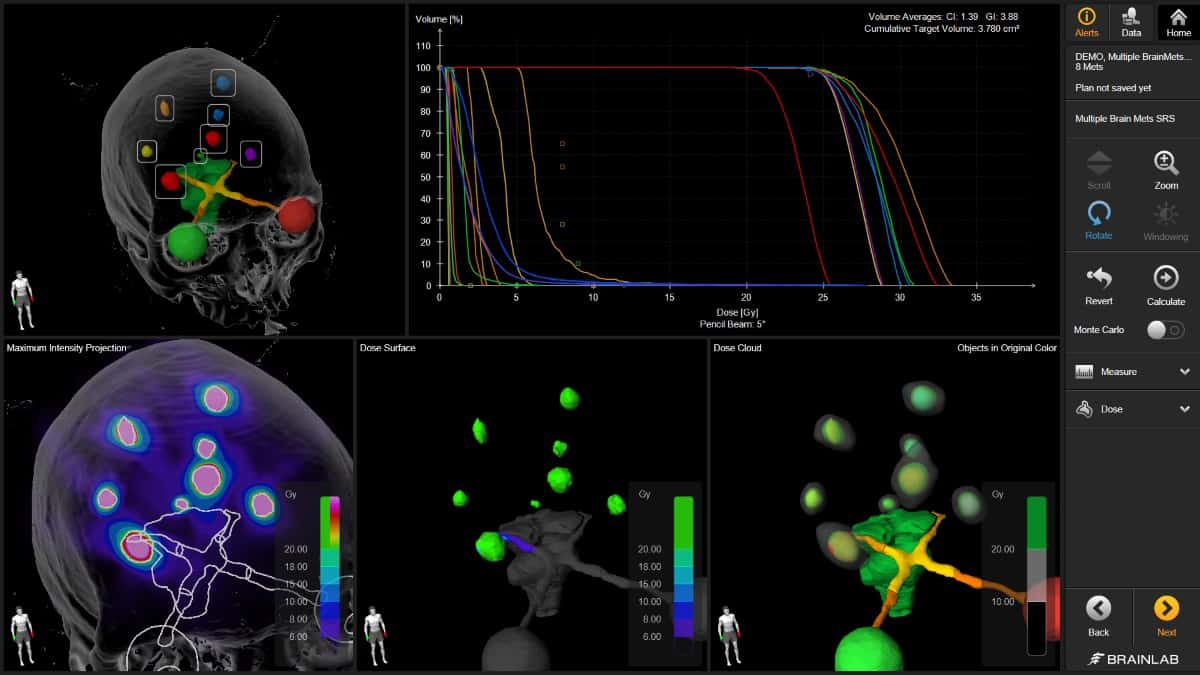Brainlab’s treatment planning software and patient imaging systems provide key building blocks in the stereotactic radiosurgery programme at Scripps MD Anderson Cancer Center

Simplicity, automation, efficiency and dose targeting with sub-mm accuracy: these are the operational reference points for the radiation oncology team running the stereotactic radiosurgery (SRS) programme at Scripps MD Anderson Cancer Center in San Diego, California. Underpinning that stereotactic clinical workflow is a portfolio of enabling technologies from Brainlab, a German healthcare equipment maker specializing in hardware and software products for SRS, surgical navigation and the next-generation “digital operating room”.
“Think automated treatment planning, high-precision patient positioning plus online imaging and thermal surface guidance,” says Steve Kirsner, director of medical physics at Scripps MD Anderson. “Our established suite of Brainlab products makes it easy for physicists to do what they have to do, allowing us to deliver high-quality care to our cancer patients every time. You can’t ask for more than that.”
Kirsner, for his part, heads up a 16-strong multidisciplinary clinical team (eight medical physicists and eight dosimetrists) working across three radiotherapy centres in the greater San Diego area. Right now, those three clinics treat around 160 patients a day, with a fourth facility being commissioned ahead of coming online for initial patient treatments in August. “We run a busy SRS linac schedule for diverse brain indications,” adds Kirsner. “That’s complemented by an extensive programme of stereotactic body radiotherapy (SBRT) to treat a range of cancer types, including prostate, lung, spine, liver, pancreas and oligometastasis.”
End-to-end workflows
In developing its SRS programme, the Scripps MD Anderson team has worked closely with Brainlab engineers to implement indication-specific, end-to-end workflows for a range of brain stereotactic treatments. That specificity means the algorithms in Elements, Brainlab’s à la carte treatment planning software, are able to address the unique clinical challenges surrounding a given disease indication. Elements Cranial SRS, for example, automatically creates SRS treatment plans for complex cranial indications – including, but not limited to, vestibular schwannomas, meningiomas and large metastases – while Elements Multiple Brain Mets SRS dose planning enables the delivery of highly conformal single-session treatments for multiple metastases, minimizing dose spread to adjacent healthy tissue and critical structures.
“Elements is one of the most user-friendly platforms for SRS treatment planning,” explains Kirsner. That ease of use is particularly important when running a medical physics service across multiple sites and multiple teams. It’s straightforward, for example, to create a set of standard planning templates for a given clinical indication. Those templates can then be shared across every facility to give treatment planners a common baseline and reference point from which to develop individualized SRS plans on a patient-by-patient basis. “Put simply,” adds Kirsner, “Elements has enabled us to create a unified framework for treatment planning, driving standardization and best practice across multiple Scripps MD Anderson treatment facilities.”
It helps, of course, that Elements offers a streamlined, automated process to arrive at a high-quality SRS treatment plan, while verification of the plan and translation to the treatment machine are equally friction-free. All of which equates to a win-win for healthcare providers and patients. “Efficiency and patient throughput are key metrics for any oncology centre,” says Kirsner, “while there’s a growing demand from patients for the benefits associated with SRS treatment schedules – not least fewer visits to the clinic and a faster return to family and friends.”
Alongside Elements for treatment planning, Kirsner’s team is also taking advantage of Brainlab’s in-room X-ray-based ExacTrac positioning and monitoring system. ExacTrac X Ray enables robust verification of patient positioning – to isocentre with sub-mm accuracy – as well as intrafractional monitoring of patient motion and internal anatomical shifts during treatment. The latest iteration of the platform, ExacTrac Dynamic, is able to track patient position along an additional coordinate – using a 4D thermal camera to create a hybrid thermal image that correlates the patient’s heat signature to their reconstructed 3D surface structure.

ExacTrac Dynamic is currently being installed as part of the commissioning of the fourth Scripps MD Anderson radiotherapy clinic, with the three established treatment centres all due to upgrade to the new imaging system by the end of this year. “We like the intuitive user experience with ExacTrac,” says Kirsner, “and the fact that it allows us to image what we treat at all times, regardless of couch angle or gantry position.” In addition, the new thermal surface guidance capability will allow Kirsner and his team to automatically track both internal and external motion throughout the entire treatment of the patient. “ExacTrac imaging also integrates seamlessly with our Varian machines,” Kirsner adds. “This will allow treatment to be paused if either the X-ray imaging or surface guidance are deemed out of tolerance – so we’re excited to see the clinical impact of the latest surface-tracking functionality in ExacTrac Dynamic.”
Clinical validation
While the near-term priority for Kirsner and colleagues is the commissioning and go-live of their new radiotherapy facility, the team is also focused on achieving Novalis-Certified status by year-end. Novalis Certification is an independent accreditation programme that offers formal recognition of the highest clinical standards in SRS/SBRT treatment delivery. As such, a key outcome for cancer treatment centres is the implementation of standardized protocols for continual self-assessment and quality improvement, further reinforcing the access that Brainlab customers get to Novalis Circle, a global network of oncology centres dedicated to best practice, knowledge-sharing and collaboration on all aspects of SRS/SBRT.
“I see the independent audit of Novalis certification as a great way to strengthen the SRS/SBRT programme at Scripps MD Anderson,” concludes Kirsner. “We are all doing the best we can for our patients, but you can always learn something new from colleagues running their own radiotherapy programmes. It’s my belief that our practice here is already Novalis-compliant, so the next step is to formally document those processes and workflows for external review.”




